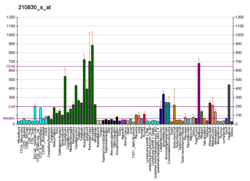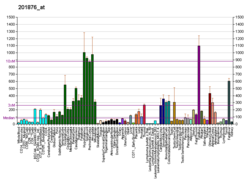Protein-coding gene in the species Homo sapiens
| PON2 |
|---|
|
| Identifiers |
|---|
| Aliases | PON2, paraoxonase 2 |
|---|
| External IDs | OMIM: 602447; MGI: 106687; HomoloGene: 385; GeneCards: PON2; OMA:PON2 - orthologs |
|---|
| Gene location (Human) |
|---|
 | | Chr. | Chromosome 7 (human)[1] |
|---|
| | Band | 7q21.3 | Start | 95,404,862 bp[1] |
|---|
| End | 95,435,329 bp[1] |
|---|
|
| Gene location (Mouse) |
|---|
 | | Chr. | Chromosome 6 (mouse)[2] |
|---|
| | Band | 6 A1|6 1.99 cM | Start | 5,264,147 bp[2] |
|---|
| End | 5,298,455 bp[2] |
|---|
|
| RNA expression pattern |
|---|
| Bgee | | Human | Mouse (ortholog) |
|---|
| Top expressed in | - right lung
- nucleus accumbens
- right adrenal cortex
- amygdala
- putamen
- external globus pallidus
- jejunal mucosa
- ventricular zone
- left adrenal gland
- caudate nucleus
|
| | Top expressed in | - epithelium of stomach
- epithelium of lens
- ciliary body
- stroma of bone marrow
- mucous cell of stomach
- retinal pigment epithelium
- skin of external ear
- corneal stroma
- ileum
- right lung lobe
|
| | More reference expression data |
|
|---|
| BioGPS | 
 | | More reference expression data |
|
|---|
|
| Gene ontology |
|---|
| Molecular function | - hydrolase activity
- metal ion binding
- identical protein binding
- arylesterase activity
- acyl-L-homoserine-lactone lactonohydrolase activity
| | Cellular component | - plasma membrane
- lysosome
- mitochondrion
- nucleus
- membrane
- intracellular membrane-bounded organelle
- extracellular region
| | Biological process | - aromatic compound catabolic process
- response to oxidative stress
- response to toxic substance
- lipoxygenase pathway
| | Sources:Amigo / QuickGO |
|
| Orthologs |
|---|
| Species | Human | Mouse |
|---|
| Entrez | | |
|---|
| Ensembl | | |
|---|
| UniProt | | |
|---|
| RefSeq (mRNA) | | |
|---|
| RefSeq (protein) | | |
|---|
| Location (UCSC) | Chr 7: 95.4 – 95.44 Mb | Chr 6: 5.26 – 5.3 Mb |
|---|
| PubMed search | [3] | [4] |
|---|
|
| Wikidata |
| View/Edit Human | View/Edit Mouse |
|
Serum paraoxonase/arylesterase 2 is an enzyme that in humans is encoded by the PON2 gene.[5][6][7]
This gene encodes a member of the paraoxonase gene family, which includes three known members located adjacent to each other on the long arm of chromosome 7. The encoded protein is ubiquitously expressed in human tissues, membrane-bound, and may act as a cellular antioxidant, protecting cells from oxidative stress. Hydrolytic activity against acylhomoserine lactones, important bacterial quorum-sensing mediators, suggests the encoded protein may also play a role in defense responses to pathogenic bacteria. Mutations in this gene may be associated with vascular disease and a number of quantitative phenotypes related to diabetes. Alternatively spliced transcript variants encoding different isoforms have been described.[7]
References
- ^ a b c GRCh38: Ensembl release 89: ENSG00000105854 – Ensembl, May 2017
- ^ a b c GRCm38: Ensembl release 89: ENSMUSG00000032667 – Ensembl, May 2017
- ^ "Human PubMed Reference:". National Center for Biotechnology Information, U.S. National Library of Medicine.
- ^ "Mouse PubMed Reference:". National Center for Biotechnology Information, U.S. National Library of Medicine.
- ^ Primo-Parmo SL, Sorenson RC, Teiber J, La Du BN (Sep 1996). "The human serum paraoxonase/arylesterase gene (PON1) is one member of a multigene family". Genomics. 33 (3): 498–507. doi:10.1006/geno.1996.0225. PMID 8661009.
- ^ Mochizuki H, Scherer SW, Xi T, Nickle DC, Majer M, Huizenga JJ, Tsui LC, Prochazka M (Aug 1998). "Human PON2 gene at 7q21.3: cloning, multiple mRNA forms, and missense polymorphisms in the coding sequence". Gene. 213 (1–2): 149–57. doi:10.1016/S0378-1119(98)00193-0. PMID 9714608.
- ^ a b "Entrez Gene: PON2 paraoxonase 2".
Further reading
- Mackness B, Durrington PN, Mackness MI (2003). "The paraoxonase gene family and coronary heart disease". Curr. Opin. Lipidol. 13 (4): 357–62. doi:10.1097/00041433-200208000-00002. PMID 12151850. S2CID 22912885.
- Getz GS, Reardon CA (2005). "Paraoxonase, a cardioprotective enzyme: continuing issues". Curr. Opin. Lipidol. 15 (3): 261–7. doi:10.1097/00041433-200406000-00005. PMID 15166781. S2CID 23497678.
- Ng CJ, Shih DM, Hama SY, et al. (2005). "The paraoxonase gene family and atherosclerosis". Free Radic. Biol. Med. 38 (2): 153–63. doi:10.1016/j.freeradbiomed.2004.09.035. PMID 15607899.
- Hegele RA, Connelly PW, Scherer SW, et al. (1997). "Paraoxonase-2 gene (PON2) G148 variant associated with elevated fasting plasma glucose in noninsulin-dependent diabetes mellitus". J. Clin. Endocrinol. Metab. 82 (10): 3373–7. CiteSeerX 10.1.1.541.2763. doi:10.1210/jcem.82.10.4289. PMID 9329371. S2CID 13102917.
- Sanghera DK, Aston CE, Saha N, Kamboh MI (1998). "DNA polymorphisms in two paraoxonase genes (PON1 and PON2) are associated with the risk of coronary heart disease". Am. J. Hum. Genet. 62 (1): 36–44. doi:10.1086/301669. PMC 1376796. PMID 9443862.
- Sanger Centre, The; Washington University Genome Sequencing Cente, The (1999). "Toward a complete human genome sequence". Genome Res. 8 (11): 1097–108. doi:10.1101/gr.8.11.1097. PMID 9847074.
- Ng CJ, Wadleigh DJ, Gangopadhyay A, et al. (2002). "Paraoxonase-2 is a ubiquitously expressed protein with antioxidant properties and is capable of preventing cell-mediated oxidative modification of low density lipoprotein". J. Biol. Chem. 276 (48): 44444–9. doi:10.1074/jbc.M105660200. PMID 11579088.
- Hong SH, Song J, Min WK, Kim JQ (2002). "Genetic variations of the paraoxonase gene in patients with coronary artery disease". Clin. Biochem. 34 (6): 475–81. doi:10.1016/S0009-9120(01)00257-0. PMID 11676977.
- Obineche EN, Frossard PM, Bokhari AM (2002). "An association study of five genetic loci and left ventricular hypertrophy amongst Gulf Arabs". Hypertens. Res. 24 (6): 635–9. doi:10.1291/hypres.24.635. PMID 11768721.
- Janka Z, Juhász A, Rimanóczy AA, et al. (2002). "Codon 311 (Cys --> Ser) polymorphism of paraoxonase-2 gene is associated with apolipoprotein E4 allele in both Alzheimer's and vascular dementias". Mol. Psychiatry. 7 (1): 110–2. doi:10.1038/sj/mp/4000916. PMID 11803456.
- Kao Y, Donaghue KC, Chan A, et al. (2002). "Paraoxonase gene cluster is a genetic marker for early microvascular complications in type 1 diabetes". Diabet. Med. 19 (3): 212–5. doi:10.1046/j.1464-5491.2002.00660.x. PMID 11918623. S2CID 11658029.
- Chen Q, Reis SE, Kammerer CM, et al. (2003). "Association between the severity of angiographic coronary artery disease and paraoxonase gene polymorphisms in the National Heart, Lung, and Blood Institute-sponsored Women's Ischemia Syndrome Evaluation (WISE) study". Am. J. Hum. Genet. 72 (1): 13–22. doi:10.1086/345312. PMC 378617. PMID 12454802.
- Strausberg RL, Feingold EA, Grouse LH, et al. (2003). "Generation and initial analysis of more than 15,000 full-length human and mouse cDNA sequences". Proc. Natl. Acad. Sci. U.S.A. 99 (26): 16899–903. Bibcode:2002PNAS...9916899M. doi:10.1073/pnas.242603899. PMC 139241. PMID 12477932.
- Hillier LW, Fulton RS, Fulton LA, et al. (2003). "The DNA sequence of human chromosome 7". Nature. 424 (6945): 157–64. Bibcode:2003Natur.424..157H. doi:10.1038/nature01782. PMID 12853948.
- Yamada Y, Ando F, Niino N, et al. (2003). "Association of polymorphisms of paraoxonase 1 and 2 genes, alone or in combination, with bone mineral density in community-dwelling Japanese". J. Hum. Genet. 48 (9): 469–75. doi:10.1007/s10038-003-0063-x. PMID 12955589.
- Shi J, Zhang S, Tang M, et al. (2004). "Possible association between Cys311Ser polymorphism of paraoxonase 2 gene and late-onset Alzheimer's disease in Chinese". Brain Res. Mol. Brain Res. 120 (2): 201–4. doi:10.1016/j.molbrainres.2003.10.018. PMID 14741412.


















